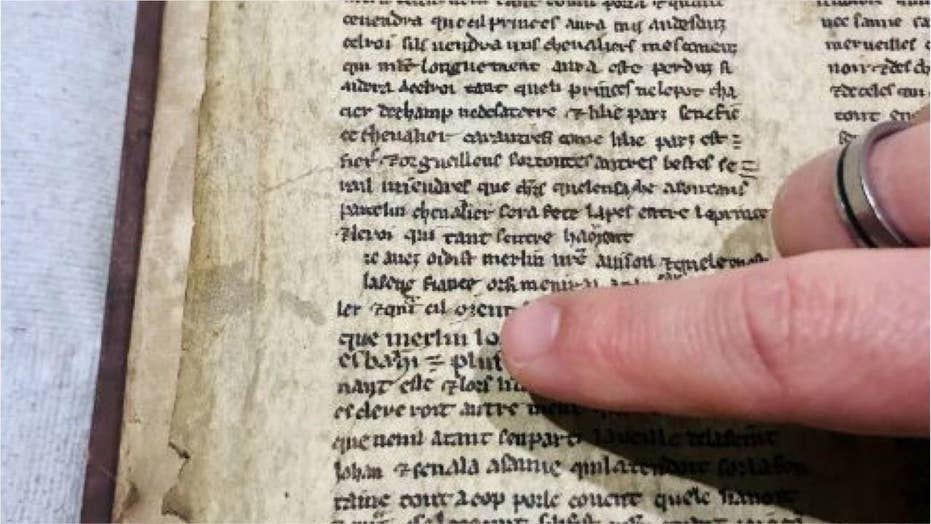The Art Of Medieval Book Covers: Illustrating The Tales Of Merlin And Arthur

Table of Contents
Materials and Techniques of Medieval Book Covers
The creation of medieval book covers, particularly those showcasing the tales of Merlin and Arthur, was a painstaking process requiring skill and artistry. The materials used reflected the status and importance of the book itself. High-status individuals and institutions often commissioned books with lavish covers.
- Parchment and Vellum: Animal skins, carefully prepared and stretched, formed the base for many covers. Vellum, made from calfskin, was particularly prized for its smoothness and fine texture.
- Wood: Wooden boards provided a rigid structure, protecting the delicate pages within. These were often covered with other materials.
- Leather: A popular choice, leather offered durability and allowed for intricate decorative techniques. Cowhide, goatskin, and sheepskin were commonly used.
- Precious Metals: Gold and silver, sometimes inlaid or applied as leaf, added a touch of opulence to the most prestigious books.
- Precious Stones and Jewels: Further enhancing the luxurious nature of some covers, precious stones and jewels were sometimes used as embellishments, adding to their monetary and symbolic value.
Several techniques were employed to decorate these covers, reflecting the medieval bookbinding techniques of the time:
- Blind Tooling: This involved pressing heated tools into the leather to create embossed designs. This technique produced a textured effect, often creating patterns or repeating motifs.
- Gold Tooling: Gold leaf was applied to the leather and then impressed with tools, creating elegant gilded designs that enhanced the cover's visual appeal.
- Painting and Gilding: Many covers featured vibrant painted illustrations, often depicting scenes from the Arthurian legends. Gilding, the application of gold leaf, was used to highlight key elements and add a lustrous finish. These medieval manuscript illumination techniques were crucial in bringing the stories to life on the cover itself.
These techniques not only contributed to the aesthetic beauty of the book covers but also played a vital role in preserving the precious manuscripts within.
Visual Representations of Merlin in Medieval Book Covers
Merlin, the enigmatic prophet and magician, features prominently in many illuminated manuscripts. His portrayal varied across different manuscripts, reflecting the evolving interpretations of his character throughout the Middle Ages. Merlin illustrations often emphasized his magical abilities and his role as a pivotal figure in Arthurian lore.
Common symbolic representations included:
- Merlin as a Wise Old Man: Often depicted with a long beard and robe, emphasizing his wisdom and prophetic abilities.
- Merlin as a Magician: Showcased performing spells, brewing potions, or interacting with magical creatures, highlighting his mastery of arcane arts. Medieval Merlin depictions frequently incorporated fantastical elements to represent his powers.
- Merlin with Magical Creatures or Objects: He was often shown with dragons, owls, or other mystical beings, further emphasizing his connection to the supernatural.
(Ideally, this section would include images of specific illuminated manuscripts depicting Merlin. Copyright restrictions may prevent this.)
Depicting Merlin's Prophecies
Scenes depicting Merlin's prophecies were often rendered with symbolic imagery to emphasize the mystical and prophetic aspects of his character. Artists used visual cues to communicate the weight and importance of his pronouncements. This could include elements like celestial bodies, visions, or symbolic objects representing future events. The artistic choices made emphasized the otherworldly nature of his predictions.
Visual Representations of King Arthur and the Knights of the Round Table in Medieval Book Covers
King Arthur, the iconic figure of chivalry and justice, was often depicted on book covers as a regal and powerful figure. Arthurian illustrations commonly highlighted his bravery, wisdom, and noble bearing.
- King Arthur: Portrayed in majestic attire, often seated on his throne or leading his knights into battle.
- Knights of the Round Table: Individual knights were often represented with their unique heraldic symbols, armor, and weapons, reflecting their personalities and roles within the court.
- Battles, Tournaments, and Courtly Scenes: Miniature depictions of battles, tournaments, and courtly life provided glimpses into the world of Arthurian legend. These small-scale narratives provided a visual summary of the stories contained within.
(Again, images of specific manuscripts would significantly enhance this section. Copyright permission would be needed.) Medieval Arthurian art frequently focused on these dynamic scenes of courtly life and warfare. King Arthur book covers often aimed to capture the essence of the epic narrative.
The Role of Book Covers in Preserving and Disseminating Arthurian Legends
Medieval book covers played a significant role in preserving and disseminating the Arthurian legends. The visual narratives on the covers acted as a kind of synopsis, attracting potential readers and conveying the essence of the stories within.
- Visual Storytelling: The images on the covers served as a visual shorthand, capturing key moments and characters from the epic narratives.
- Attracting Readers: Intricate designs and vibrant colors made the books visually appealing, encouraging readers to pick them up and delve into the fascinating tales.
- Preservation of Tales: The covers, with their protective function, contributed to the preservation of the manuscripts themselves, ensuring that the stories could be passed down through generations.
- Scribes and Illuminators: The skilled scribes and illuminators who created these iconic works played a vital role in shaping the visual language of Arthurian legend, influencing how the stories were perceived and understood. Their contribution to Medieval book illustration was indispensable.
The Arthurian legend preservation was significantly aided by the meticulous work of these artists. Medieval manuscript preservation efforts are crucial today to ensure that these beautiful and historically significant artifacts are kept safe for future generations.
Conclusion
The artistry of medieval book covers, particularly those illustrating the tales of Merlin and Arthur, provides a fascinating glimpse into the cultural and artistic landscape of the Middle Ages. These miniature masterpieces, crafted with meticulous detail and skill, weren't merely functional; they were active participants in the storytelling process, bringing the legendary figures of Arthurian lore to life for generations of readers. By studying the materials, techniques, and imagery employed in these medieval book covers, we gain a deeper appreciation for the rich history and enduring appeal of the Arthurian legends and the artistry of medieval manuscript illumination. To delve further into this captivating world, explore online resources dedicated to medieval book illustration and visit museums housing collections of illuminated manuscripts.

Featured Posts
-
 Henry Cavills The Ministry Of Ungentlemanly Warfare Why It Didnt Connect With Audiences
May 11, 2025
Henry Cavills The Ministry Of Ungentlemanly Warfare Why It Didnt Connect With Audiences
May 11, 2025 -
 Thomas Mueller Quitte Le Bayern Munich Apres 25 Ans L Annonce Officielle
May 11, 2025
Thomas Mueller Quitte Le Bayern Munich Apres 25 Ans L Annonce Officielle
May 11, 2025 -
 New Calvin Klein Campaign Featuring Lily Collins Image 5133599
May 11, 2025
New Calvin Klein Campaign Featuring Lily Collins Image 5133599
May 11, 2025 -
 Payton Pritchard The Details Behind His Improved Nba Performance
May 11, 2025
Payton Pritchard The Details Behind His Improved Nba Performance
May 11, 2025 -
 Marjolein Fabers Protest Photo Controversy Potential Lawsuit
May 11, 2025
Marjolein Fabers Protest Photo Controversy Potential Lawsuit
May 11, 2025
